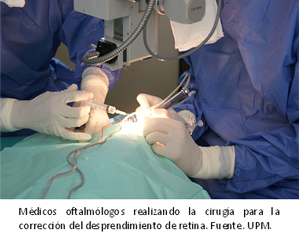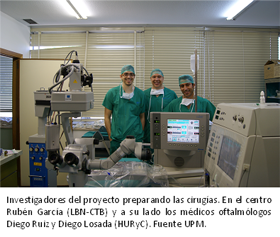Progress in the treatment of retinal detachment
Researchers of the Univesidad Politécnica de Madrid are involved in the development of an ocular device based on ferrofluid nanoparticles which improves the outcomes of operations and postoperative care
 The new methodology is the result of a collaboration between the Ramón y Cajal University Hospital, the Universidad Autónoma de Madrid, the The Biomedical Research Networking Center in Bioengineering, Biomaterials and Nanomedicine (CIBER-BBN), and researchers for the Centre for Biomedical Technology of the UPM. The new method dramatically improves the postoperative care because it prevents uncomfortable cephalic positions, inflammation, possible cataracts and relapse. In addition, the patients’ vision is immediately improved from day one.
The new methodology is the result of a collaboration between the Ramón y Cajal University Hospital, the Universidad Autónoma de Madrid, the The Biomedical Research Networking Center in Bioengineering, Biomaterials and Nanomedicine (CIBER-BBN), and researchers for the Centre for Biomedical Technology of the UPM. The new method dramatically improves the postoperative care because it prevents uncomfortable cephalic positions, inflammation, possible cataracts and relapse. In addition, the patients’ vision is immediately improved from day one.
The high global incidence of the injury has made treating retinal detachment a common ophthalmological procedure. Additionally, 50% of all cases require a second intervention.
Today, the most common way to correct retinal detachment requires incisions in the eye that allows the surgeon to reattach the retina in the right place and then, to inject a substance known as a stopper that blocks the hole caused by the detachment.
To ensure this substance is effective, the patient must be in a specific posture, which is very uncomfortable. A stopper that improves quality of life in patients would have a major social impact.
 Researchers have succeeded in designing a magnetic ocular implant that uses a ferrofluid as a stopper. Magnetic particles are injected intraocularly towards the area of the retinal detachment through a magnetic field created by a magnet sutured to the sclera (outer wall of the eye). This allows patients to be in a more comfortable position.
Researchers have succeeded in designing a magnetic ocular implant that uses a ferrofluid as a stopper. Magnetic particles are injected intraocularly towards the area of the retinal detachment through a magnetic field created by a magnet sutured to the sclera (outer wall of the eye). This allows patients to be in a more comfortable position.
The device has only been tested on animals so far, but its functionality has been proven successful in over 80% of cases. In addition, production is less expensive, which makes it an interesting solution for ophthalmic surgery today. The invention is protected by a patent and is currently marketed.
The researchers responsible for the survey belong to the Bioinstrumentation and Nanomedicine (LBN) of the CTB-UPM, Dr. José Javier Serrano Olmedo and Rubén Antonio García Mendoza, also from the Department of ophthalmology of the Ramón y Cajal University Hospital, Dr. Francisco Muñoz Negrete, Diego Ruiz Casas and Diego Losada Bayo and the groupo of the UAM Advanced Materials and Nanotechnology, Dr. Miguel Manso Silván and Dr. Álvaro Muñoz Noval.
SOURCE: UPM

